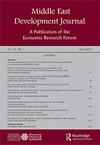Effect of oil revenues on size and income of Iranian middle class
IF 0.9
Q4 DEVELOPMENT STUDIES
引用次数: 3
Abstract
ABSTRACT This paper investigates the effect of oil revenues on the middle-class size and income in Iran. Following Kharas (2017. The unprecedented expansion of the global middle class: An update. The Brookings Institution), it uses an absolute measure to define the middle class as those who earn between US$11 and US$110 per day (2011 PPP). The study employs annual time series data for 1965–2017 and a Vector Autoregressive (VAR) model along with impulse response and variance decomposition analyses. Findings indicate that the response of the middle class to positive oil-income shocks in Iran is positive and significant. It is further shown that the channels of international non-oil trade, service sector, and overall economic development are important in understanding the relationship between the oil income and the middle class in Iran. These results are robust when controlling for other channels in the nexus of oil income and middle class as well as alternative definitions of middle-class income based on relative measures obtained from Iran’s income and expenditure household surveys.石油收入对伊朗中产阶级规模和收入的影响
本文研究了石油收入对伊朗中产阶级规模和收入的影响。继Kharas之后(2017。全球中产阶级的空前扩张:最新情况。布鲁金斯学会),它使用一个绝对的衡量标准来定义中产阶级,即每天收入在11美元至110美元之间的人(2011年购买力平价)。该研究采用了1965年至2017年的年度时间序列数据和向量自回归(VAR)模型以及脉冲响应和方差分解分析。研究结果表明,伊朗中产阶级对积极的石油收入冲击的反应是积极和显著的。研究进一步表明,国际非石油贸易、服务业和整体经济发展的渠道对于理解伊朗石油收入与中产阶级之间的关系很重要。当控制石油收入和中产阶级之间的其他渠道,以及基于伊朗收入和支出家庭调查的相对指标对中产阶级收入的替代定义时,这些结果是稳健的。
本文章由计算机程序翻译,如有差异,请以英文原文为准。
求助全文
约1分钟内获得全文
求助全文

 求助内容:
求助内容: 应助结果提醒方式:
应助结果提醒方式:


